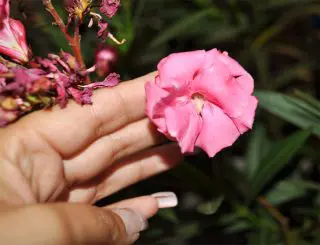Question: How toxic is oleander for humans? Many are considering whether to plant an oleander in the garden, so would like to know the risks …
Oleander is one of the most poisonous plants you can have in your garden. A person can die just chewing part of a leaf or using the stems to spear food. All parts of the oleander plant are poisonous, including the leaves, stems, seeds, flowers and the nectar in the flowers. Honey made from oleander flowers is also poisonous.
Because of the dangers, oleander should not be planted where children or pets (because oleander is also toxic to animals) play. Some gardeners believe the risk is too great even in households where only adults live. If you are considering planting an oleander in your own yard, you should know all you can about the plant’s toxicity.
Contents
Poisoning by oleander in humans
Two cardiac glycosides, oleandroside and nerioside, as well as digitoxigenin, neriin and oleandrin make oleander toxic.
Symptoms of poisoning include diarrhea, dizziness, cardiac arrhythmias, nausea, severe stomach pain, vomiting, and weakness. People who have consumed oleander may also have dilated eyes. Severe poisoning can result in respiratory paralysis, coma or death.
If you think someone has oleander poisoning, contact your doctor immediately.
Touching the oleander plant is less dangerous, but can cause skin irritation, especially if the skin comes into contact with the plant’s sap.
Oleander poisoning in animals
The plant is also toxic to pets. Symptoms of oleander poisoning in an animal include colic, diarrhea that may contain blood, difficulty breathing or shallow breathing, loss of coordination and sweating.
Animals that have consumed oleander may also be unable to stand or have muscle tremors. If you suspect your pet has oleander poisoning, contact your veterinarian immediately.
Precautions to take with oleander in the garden
If you have worked with oleander, please wash your hands immediately afterwards. (Yes, even if you wore gloves).
Also clean garden tools after they have come in contact with oleander.
Also, please do not burn oleander cuttings or parts of the plant. The smoke can cause skin and throat irritation.
Also, do not put oleander in a compost pile to use the compost later for vegetable plants.
If oleander debris or other remains of an oleander plant must be disposed of, do so with all caution. It is best packed in a bag in the residual waste. (Wash your hands thoroughly afterwards).
Now you have the information you need to make an informed decision about whether to grow oleander in your garden.
Have fun with it – but always use caution….


